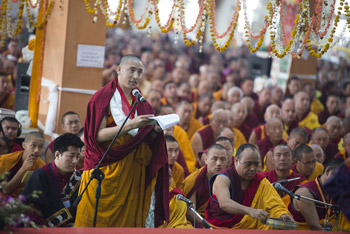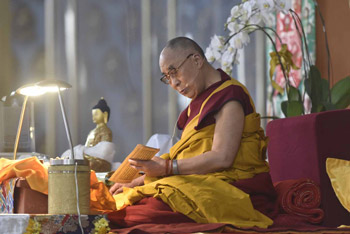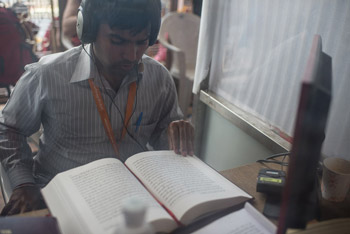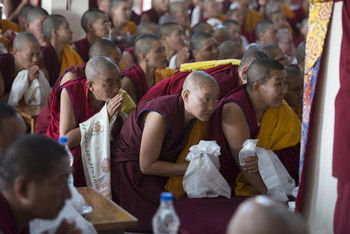Mundgod, Karnataka, India, 28 December 2014 - “Today, the people of Mundgod settlement have gathered together to perform a long life prayer on my behalf,” announced His Holiness the Dalai Lama this morning. “They are joined by people from Dzachukha, the native place of Dza Patrul Rinpoche. They represent the people in Tibet. I’ve read the mandala prayer and request, so you can abbreviate it if you like. I’ve read the letter from the Dzachukha people too.

|
A representative for the Dzachukha people reading the mandala prayer and request during the Long Life Offering ceremony for His Holiness the Dalai Lama at Ganden Jangtse Monastery in Mundgod, Karnataka, India on December 28, 2014.
Photo/Tenzin Choejor/OHHDL
|
"In the years since this settlement was set up, it has developed and improved. I can see this in the looks on people’s faces and the fact that their complexions have improved.”
The letter from the Dzachukha people mentioned His Holiness’s previous lives, including the 36 manifestations of Avalokiteshvara in India. It said: ‘you have shown kindness to the people of Tibet by leading us. We would like to repay a pinch of that kindness through this offering. His Holiness responded:
“It is the people back in Tibet who are the real owners of the land. I am only a spokesman for them. As I say, the land of Tibet belongs to the people who live there, and it’s because of the persistent strength of spirit of the people of Tibet that we are able to work on their behalf in exile.”
When the prayer was over, announcements were made to clarify how much money had been given for the events of the last six days and how much had been spent. The surplus was set aside for teachings His Holiness has said he will give next year.
Resuming his reading of Zhamar Pandita’s Lam Rim His Holiness remarked that the Buddha showed a path that hinges on dependent arising. He taught the Four Noble Truths on the basis of emptiness and His Holiness remarked that emptiness remains the ultimate reality whether Buddhas appear or not. With regard to the Four Noble Truths, the Buddha said, “Know suffering, overcome its origin, achieve cessation and cultivate the path. Nevertheless, in the end there is nothing to be known, nothing to be overcome, nothing to be achieved and nothing to be cultivated.” The three principles of the path are the determination to be free, the awakening mind of bodhichitta and the wisdom understanding emptiness.
Following Shantideva, His Holiness said bodhichitta is the fundamental source of all goodness. He noted there are two systems for cultivating it: the 7 point cause and effect and exchanging self and others. We can see the benefits with our own eyes, but what obstructs our developing bodhichitta is the self-cherishing attitude.

|
His Holiness the Dalai Lama during the final day of his teaching at Ganden Jangtse Monastery in Mundgod, Karnataka, India on December 28, 2014. Photo/Rio Helmi/JLTOC
|
In the text, the survey of lower realms of existence moved on from the hells to the realms of animals and hungry ghosts. Amongst the sufferings experienced by animals is hunger and thirst, fear, stupidity, being used as beasts of burden and being killed for sacrifice.
The description of hungry ghosts, that their mouths are like the eye of a needle, while their necks and throats are as thin as the needle, reminded His Holiness of the case of a Namgyal Monastery monk called Choenze Goshak who was born as such a spirit. He was someone who often used to visit Trijang Rinpoche when His Holiness was at the Norbulingka in Tibet. The Namgyal Monastery chant master intervened and asked Trijang Rinpoche what had happened. It seems Choenze Goshak favoured some spirit to whom a shrine was dedicated and prepared some small shoes to offer there. As a result, when he died, although it may have seemed that the spirit was helping him, in fact he ended up being reborn in the retinue of that spirit.
His Holiness remarked that those who propitiate Dolgyal run a similar risk of being born as ghosts or spirits.
“They may dismiss my advice, but the risk is there.
Changing direction, he said:
“Because we want to be free of cyclic existence, we take refuge in the Buddha, Dharma and Sangha. They are an infallible refuge because of being free of all faults and endowed with all realizations. In order to reach Buddhahood and in order to protect us from lower rebirth, generating bodhichitta in addition to taking refuge is very effective. It enables us to accumulate great merit.”
The text went to great lengths to explain the qualities of the Buddha, listing his major and minor marks, for example, the thousand spoked Dharma wheels that mark his feet and hands. The cause of these is welcoming your Lama and seeing him off. The Buddhas have proceeded through the bodhisattva grounds culminating in enlightenment. After initially generating bodhichitta, they accumulate method and wisdom for three countless aeons.

|
The Hindi language translator working during the last day of His Holiness the Dalai Lama's teachings at Ganden Jangtse Monastery in Mundgod, Karnatak, India on December 28, 2014. Photo/Tenzin Choejor/OHHDL
|
Having rehearsed the qualities of the Three Jewels, Zhamar Pandita’s book describes what to do and what not to do when you take refuge in them. It recommends that you should avoid objects that give rise to disturbing emotions. The benefit of taking refuge in this way is that you generate tremendous merit, while every moment reduces your huge accumulation of negative karma. Besides this, by taking refuge in Buddha, Dharma and Sangha you become a Buddhist and you will be protected against the depredations of harmful spirits. His Holiness reached the end of the section in Zhamar’s Lam Rim concerning the attainment of a good rebirth in the next life. He then briefly read from ‘Liberation in the Palm of Your Hand’.
As a concise way of generating bodhichitta, His Holiness said he would like to recite with all those present who wished to do so, the common verse that combines taking refuge and generating the awakening mind.
“All sentient beings want to avoid suffering and secure happiness. And all happiness and good in the world arises as a result of seeking to help others.”
He advised all those who wanted to do so to visualise the Buddha before them surrounded by other teachers of the tradition and to recite the formula for taking refuge and generating the awakening mind of bodhichitta. At the end, His Holiness remarked that the small ceremony marked an auspicious end to the session of teachings. He also mentioned that he recites this verse:
To the Buddha, Dharma and Spiritual Community
Until enlightenment I turn for refuge.
By whatever merit I create by generosity or listening to the teachings
May I attain Buddhahood for the sake of all sentient beings.
at the beginning and end of every day and finds it really helpful. In addition he quoted verses from the ‘Guide to the Bodhisattva’s Way of Life’ extolling bodhichitta:
It is the elixir of life produced to vanquish death in the world. It is an inexhaustible treasure eliminating the poverty of the world.
It is the supreme medicine that alleviates the illness of the world. It is the tree of rest for beings exhausted from wondering on the pathways of mundane existence.
It is the universal bridge for all travellers on their crossing over miserable states of existence. It is the rising moon of the mind that soothes the mental afflictions of the world.
It is the great sun dispelling the darkness of the world’s ignorance. It is the fresh butter formed from churning the milk of Dharma.
Leaving Ganden Jangtse Monastery at the conclusion of the teachings, His Holiness shifted his temporary residence again, this time to Drepung Lachi. On the way he visited the Nga Gyur Dor Drak Nyingma Monastery, where there is now only one monk remaining of those who originally escaped from Tibet. He went on to visit the Dokhang Khangtsen of Ganden Shartse Monastery. Nearby, at the Ganden Jangtse Hospital he inspected the impressive facilities, met the staff and comforted patients.

|
Nuns listening to His Holiness the Dalai Lama during his visit to of Changchub Choling Nunnery in Mundgod, Karnataka, India on December 28, 2014. Photo/Tenzin Choejor/OHHDL
|
At Jangchub Choeling Nunnery he commended the nuns for their studies, recalling an occasion when they visited Dharamsala and the public consensus was that they had debated the most effectively. He recalled that nuns had really begun to study seriously in the late 80s and now there were candidates in the process of taking their Geshema degrees. He said studying philosophy broadens your view and is an effective way of achieving equality. He reiterated that the Buddha had given equal opportunity to both men and women and encouraged the nuns to take advantage of it.
His Holiness took a favourable view of the philosophy teacher’s proposal to buy land from the adjacent old people’s home on which to create a debate yard because there is no longer enough space for all the nuns to debate. He told them:
“Since this is one of the best nunneries, as far as study is concerned it is our duty to support your activities and encourage your study and practice.”
Finally arriving at Drepung Lachi, His Holiness was welcomed in a traditional way with tea and sweet rice. No speeches were made. He has announced that he will give a permission of Palden Lhamo tomorrow, the final day of his stay in Mundgod. 